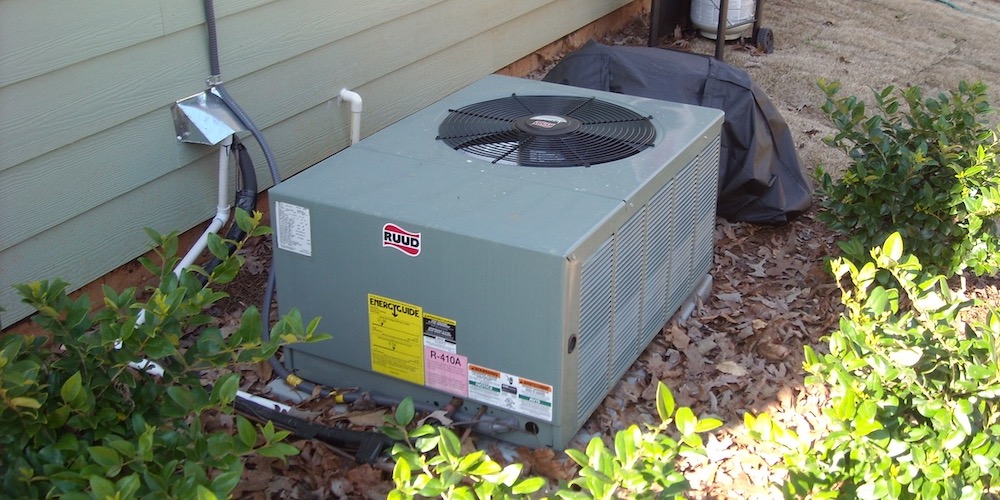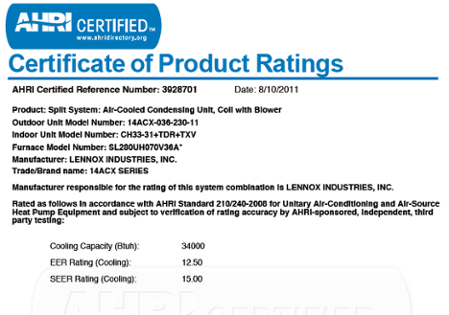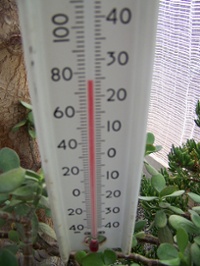3 Reasons Your 3 Ton Air Conditioner Isn’t Really 3 Tons

Of course, there are more than 3 reasons that your 3 ton air conditioner isn’t really 3 tons, starting with the fact that it’s not 3 tons in weight. That unit refers to cooling capacity and goes back to the days of ice. I’m also not talking about any of the multitude of reasons having to do with improper design, faulty installations, or lack of maintenance, topics that I discuss plenty in this space.
No, today I’m going to tell you that your 3 ton (or 2 ton or whatever size you have) air conditioner may not be what you think it is even when everything’s designed, installed, commissioned, and maintained perfectly. David Butler wrote about two of these reasons in a guest post on ACCA’s Manual S protocol for selecting HVAC equipment two years ago, and that’s a great article for understanding some of the subtleties.
So, what are these 3 reasons?
1. Nominal vs. actual capacity
The first reason is that when we talk about air conditioner capacity, we’re usually giving the nominal size. A 3 ton air conditioner has a nominal capacity of 36,000 BTU per hour, but the actual rating using the operating conditions specified by AHRI is rarely the same as the nominal capacity. For example, the AC shown in the AHRI certificate below is a 3 ton air conditioner (36,000 BTU/hr) with an actual capacity of 2.8 tons (34,000 BTU/hr).

2. AHRI’s indoor operating conditions vs. actual operating conditions
As David Butler discussed in his article on Manual S, AHRI ratings are done for an indoor dry bulb temperature of 80° F and indoor wet bulb temperature of 67° F.  ACCA recommends using an indoor design temperature (dry bulb) of 75° F and relative humidity of 50%. That’s closer to the actual conditions that most homes actually operate at than AHRI’s conditions.
ACCA recommends using an indoor design temperature (dry bulb) of 75° F and relative humidity of 50%. That’s closer to the actual conditions that most homes actually operate at than AHRI’s conditions.
Let’s think about the temperature difference and see what effect that might have on the cooling capacity. Which way do you think it would go if we bring cooler air into the air conditioner than it was rated for? Well, let’s frame that a little differently. Is it harder to cool cooler air or warmer air? The answer is the former. The lower the temperature goes, the harder it is to remove more heat from it. Just ask the folks at the Microkelvin Laboratory at the University of Florida, where they get about as close to absolute zero as is possible.
If it’s harder to cool air at 75° F than air at 80° F, then that means the 2.8 ton air conditioner above isn’t even going to be 2.8 tons. To find the answer here, you have to factor in the humidity levels, too. As David wrote, it’s a moving target, but the net result of AHRI’s operating conditions is that your air conditioner’s capacity is lower than it’s rated (unless you keep the thermostat at 80° F or higher).
3. Outdoor operating conditions for AHRI vs. actual operating conditions
AHRI uses 95° F as its outdoor test temperature, so if your outdoor cooling design temperature differs from that, your AC capacity will again vary from the AHRI rated capacity. In this case, we get a little of that lost capacity back here in Atlanta. Our design temperature is 92° F, which means that the air conditoner has an easier job of dumping heat into the outside air than it would if it had to dump the heat into 95° F air.
If you live in Tucson, Arizona, with a design temperature of 103° F, however, your 3 ton air conditioner has now dropped in capacity again. It’s just harder for that refrigerant to give up those BTUs to air that’s hotter.
More reasons for variation
It’s important to remember that the three reasons above don’t have anything to do with poor design, installation, commissioning, or maintenance. Plenty of other factors related to those issues also affect capacity:
- Bad ductwork
- Dirty filters or coils
- Poor air flow through the condensing coil
- Improper refrigerant charge
These are not good reasons to oversize an air conditioner!
The takeaways
The main thing to be aware of is that you need to know more than just the result of the Manual J cooling load calculation. A Manual J report may say you need a 3 ton air conditoner, but for the three reasons above, you might really need to install a 3.5 ton unit. That’s why Manual S, the equipment selection protocol, is so important. The thing is, though, that even with these issues that mostly reduce the capacity of your your air conditioner, most air conditioners still end up oversized.
I recently heard someone say that thumbs are great things, but it’s good to recognize their limitations. Having opposable thumbs allows us to write a letter, examine a mulberry, and hold a glass of beer, but no matter how great they are, they can’t design HVAC systems. Rules of thumb don’t work. You need to know how things really work and do the math for that.
Related Articles
What Exactly is Manual S in HVAC Design and Why Is It Important?
Why Is Air Conditioner Capacity Measured in Tons?
The Magic of Cold, Part 2 – Intermediate Air Conditioning Principles
Photo of thermometer by jetsandzeppelins from flickr.com, used under a Creative Commons license.
Comments are closed.
This Post Has 9 Comments
Comments are closed.

Allison,
Allison,
This concept of cooling performance is even less understood in the repair and maintenance field than it is in the building performance world. Measuring actual system performance in the field (in real time and in real world conditions) has been nearly impossible.
We have great hopes that our Total Performance Diagnostics will save consumers and the nation a lot of energy by identifying poorly operating systems so they can be repaired or replaced.
ernie
Home Energy Partners out of
Home Energy Partners out of Ashville, NC put together a great Manual S spreadsheet that automates a lot of the calculations. They have posted a video explaining how it works. Check it out at: http://homeenergypartners.com/2013/04/manual-s-speedsheet-2013/
Even with all these capacity
Even with all these capacity reducing factors AC units are still oversized on average by 50%.
“One needs to know
“One needs to know everything,” responded don Quixote, “in my profession.”
Another consideration,
Another consideration, although somewhat implied by the discussion of indoor rating conditions, is sensible heat ratio.
A 4 ton system typically supplies just 3 tons of sensible cooling, and loads in really hot places (such as Tucson) tend to be more sensible.
All that said, we are today merrily installing a 3 ton system on a house that loads out to 3.25 tons. Client has committed to some envelope and insulation improvements.
Ernest M.:
Ernest M.: Yes, a lot of people in the HVAC industry don’t understand this. For those wanting to see what your company offers, here’s a direct link: Total Performance Diagnostic.
: Thanks for posting the link to Isaac’s Manual S spreadsheet, here’s the direct link:
Home Energy Partners Manual S spreadsheet.
Bob: Yep. I added a sentence about that near the end that should have been there to begin with.
Bob S.: So true!
Curt K.: Yeah, I thought I’d leave the discussion of sensible and latent for another article and focus mainly on the sensible here. Not because it isn’t important, though.
You can trade sensible and
You can trade sensible and latent capacity by varying the airflow on the indoor coil. Lower cfm gives more latent, higher is more sensible. The best way is to have a blower than can vary the speed in real time to meet load requirements. Often latent loads are high when sensible is low.
Actally higher cfm increases
Actally higher cfm increases total capacity up until the coil is so warm its not removing any humidity at all. Pull the expanded performance data off your faorite brand of ac or copelands website.
Nice article Allison.
Nice article Allison. Similarly, a “SEER X” isn’t always a SEER X. A scan of the AHRI data shows the reported values within a nominal SEER family of products varies significantly. See Figure 9 in http://www.nrel.gov/docs/fy13osti/56354.pdf